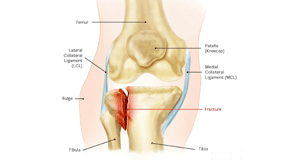Fractures of Knee
Fractures of Knee is also called as patella fracture is a break in your kneecap, the bone that covers your knee joint. It’s usually caused by a traumatic injury, such as a fall or a blow to your kneecap. A patella fracture can be simple or complex. Some fractures require surgery to repair. Recovery can be long, and side effects are common.

It’s usually caused by direct injury like a fall on your knee, a blow to your knee or a collision, lik with the dashboard in a car accident. A patella fracture is a serious injury, which can impact your ability to bend or straighten your knee. Some patella fractures are simple, but this small bone is also capable of breaking into many pieces.
Causes
Fracture of knee is usually caused by a direct impact to your knee. Depending on the force applied, it may create a hairline crack, break into two pieces or it may break into many small pieces. Patella fractures can cause the extensor mechanism of your knee to no longer function properly.
The quadriceps and patellar tendon attach to your patella, which normally allows you to flex and extend your knee. The patella is covered with cartilage, which provides a cushion for your knee joint. The cartilage can be injured with this type of fracture, which can lead to post-traumatic arthritis.
Types of Fractures of Knee
- Stable patella fracture: In a stable fracture, also called a “nondisplaced” fracture, the broken pieces of your bone remain essentially in the right place. They may still be connected to each other, or they may be separated by a millimeter or two. This type of fracture usually heals well without surgery. If your healthcare provider determines that you don’t need surgery, they will immobilize your knee in extension with either a knee immobilizer, a hinged knee brace or a cast. You’ll be allowed to bear as much weight as you’re comfortable.
- Displaced patella fracture: In a displaced fracture, your broken bone pieces have been displaced from their correct position and don’t line up with each other as they should. These pieces often need to be fixed with surgery in order to heal and allow your knee to function properly.
- Transverse patella fracture: A transverse fracture is a fracture where your patella breaks into two pieces. These breaks are often fixed with surgery. Various surgical techniques can be used to fix these injuries. Your surgeon will decide which is best for you.
- Comminuted patella fracture: In a comminuted fracture, your bone has shattered into three or more pieces. A comminuted fracture can be stable or unstable. When a comminuted fracture is unstable, some of your bone pieces may be too small to reconnect and may need to be removed in surgery.
- Open patella fracture: In an open fracture, your skin over your bone has been broken. Either your bone pieces themselves have penetrated through your skin, or something has penetrated your knee from the outside. An open fracture requires prompt treatment with antibiotics and surgery to thoroughly clean the wound. Open fractures tend to have a higher rate of infection, so it’s important to seek urgent medical treatment. Your surgeon will decide which surgical treatment will best fix your fracture.
Symptoms of Fractures of Knee
- Pain.
- Swelling.
- Inability to straighten your leg.
- Palpable patellar defect (a change in your kneecap that you can feel through your skin).
- Bruising.
- Inability to raise your extended leg.
- Inability to walk.
Diagnosis of Fractures of Knee
Orthopedic Surgeon at Shreya Hospital will ask about your symptoms and what happened at the time of the injury. Then they’ll examine your knee. They might have you try to extend your leg. If you can’t, that will likely necessitate surgical intervention. They may also be able to feel the edges of the fractured bone pieces through your skin.
Doctor will check for open wounds and for signs of hemarthrosis — blood from the broken bone pieces collecting in your joint, which can cause excessive swelling. They will take X-rays or even a CT scan to define the fracture.
 Dr Dev Mishra Best Orthopaedic Doctor in Delhi NCR Ghaziabad
Dr Dev Mishra Best Orthopaedic Doctor in Delhi NCR Ghaziabad
